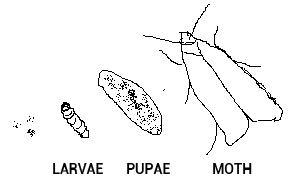About the Wool Moth
If you find moth damage to your fine wool rugs, your moth problems are probably ongoing. Besides the information offered here.
 Each year at the beginning of spring or summer, female moths start looking for suitable places to lay eggs. Moths love warm weather, and have very short life spans. Each moth lays thousands of eggs, which look like beige salt particles somewhat like sandy pebbles.
If you live in a wooded area, you are more likely to attract moths because trees block wind and offer a calm environment. Also, food and pet urine stains on your wool rugs make excellent locations for a moth to lay her eggs; the extra protein makes the wool more nutritious for the larvae.
Each year at the beginning of spring or summer, female moths start looking for suitable places to lay eggs. Moths love warm weather, and have very short life spans. Each moth lays thousands of eggs, which look like beige salt particles somewhat like sandy pebbles.
If you live in a wooded area, you are more likely to attract moths because trees block wind and offer a calm environment. Also, food and pet urine stains on your wool rugs make excellent locations for a moth to lay her eggs; the extra protein makes the wool more nutritious for the larvae.
Look for Moths in Dark & Out-of-the-Way Spots
Female moths look for dark, out-of-reach areas in your home for shade and privacy because sunlight can kill the moth larvae. The best places to look for moths, their eggs and larvae are under beds, sofas, chairs or cabinets. Unused rooms that are not cleaned or vacuumed often allow the larvae to proliferate without being disturbed. A few hours after hatching, larvae worms crawl deep down into the fibres of your rugs to escape any light source and begin to eat the wool immediately. Then they gain the strength necessary to spin a cocoon, which protects itself from the sunlight. Making them hard to detect, the cocoon’s colour is usually the same colour as the yarn that the worm eats.
The Most Destructive Stage for Your Rugs
When moth larvae travel to find richer food sources on your rugs is the most destructive time. Consuming the wool at the bottom of the pile of your rugs, the moth larvae cause the pile to fall out. Then scattered holes appear throughout your valuable wool and oriental rugs – also your wool clothing and furnishings if infected. During the cleaning process, we may find more holes on your rug because the moth larvae eat the bottom of the knots. The weakened pile falls out during vacuuming or cleaning. This is why our experts recommend careful cleaning and repair for moth damage by an experienced professional. The moth larvae only stop eating your wool rugs when they become young moths ready to mate again.
Preventing Moth Infestations
If you see any moths flying in your house, kill them. Simply vacuuming every inch of your good rugs can prevent infestation. You may want to check your wool clothing and dark places also under the furniture too. At least once each season, vacuum the front and the back of your wool rug and then inspect for moth residue on the front and the back. If you find any, clean the rug and air it out under the sun if possible. Don’t forget to change the direction of your rug too, which prevents wear and tear on the traffic areas.
Tips for Storing Wool Rugs
If you store your wool rugs for a long time, make sure you clean the rugs first and wrap them, at the least, with mothballs. We recommend wrapping in heavy craft paper rather than in plastic, which does not let the rug’s fabric breathe. Lack of ventilation may result in mildew, rotting and bad odour. Also every year before summer, you should open your stored rugs for cleaning and inspection for damage. Though not a total guarantee against damage, after applying fresh new mothballs, reroll and rewrap your rugs with heavy paper.